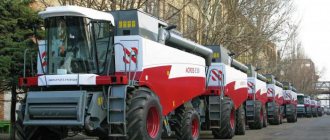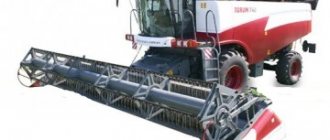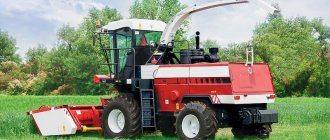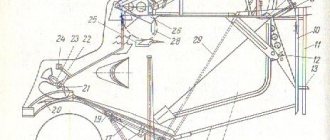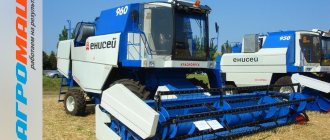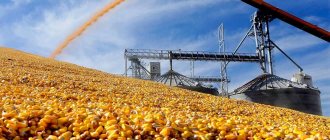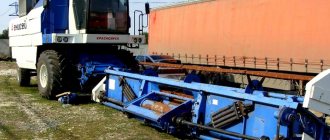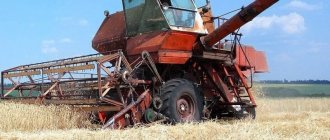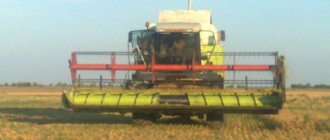The Polesie-1218 combine harvester is a reliable, time-tested, high-performance grain harvesting machine, equipped with a threshing and separating device, the width of which is 1.5 meters. A distinctive feature of this model is the fact that before threshing the flow of raw materials is noticeably accelerated. This contributes to a noticeable acceleration of work, because the threshing process begins at the concave stage.
It is also important that the presence of teeth on the accelerator drum helps to distribute the grain mass evenly, reduces the load on key components and guarantees more stable threshing, which is especially important when harvesting twisted bread.
In the process of creating this model, all the needs and nuances of the grain-growing business were taken into account, and the combine itself was designed in strict accordance with strict European standards.
How the car works
The indisputable advantage of the machine, which became the topic of our conversation, is the increased diameter of the drums - both accelerating and threshing, it is 60 and 80 cm, respectively. This is the maximum figure when comparing the Polesie combine harvester with other similar threshing machines.
This design feature ensures high threshing productivity, especially in difficult areas characterized by wet, unstable soil and contamination of the harvested crop.
It is noteworthy that for processing soils with low bearing capacity, all-wheel drive combine harvesters “Polesie-1218” were developed on the basis of this model, capable of coping with the functions assigned to them in difficult operating conditions.
It is noteworthy that the machine can also be used to assemble other crops. In particular, thanks to the possibility of using various types of adapters and easy re-equipment of the thresher, the combine does an excellent job of harvesting corn, and when the chassis is modified, it can be used to harvest rice.
The increased diameter of the drums, combined with a large area of the concave, which, by the way, is double, made it possible to extend the threshing path and make the process more gentle, thereby achieving the highest level of threshing even on crops with tall stems.
Combine harvester KZS-1218A-1 “PALESSE GS12A1”
Buying a grain harvester KZS-1218A-1 is a smart choice
This combine is one of the best in its class and occupies a worthy place among world analogues. The operational and technological characteristics of the combine have a good reputation both in our country and abroad. Moreover, unlike foreign analogues, you can buy a combine harvester of this model quite inexpensively. It is cheaper, both in cost and in operation.
KZS 1218A1 grain harvesters: features
The combine harvester of this model is a logical development of the most popular KZS-1218, but at a different stage of technical development and design thought. The new KZS 1218A1 grain harvesters have received a number of innovative solutions. Almost all basic indicators have been improved. First of all, it makes sense to consider the changes that were made by the designers.
- The reliability of the feeder chamber and the ease of its maintenance have been increased. The designers have achieved a reduction in dust levels. For this purpose, a 4-ribbed belt drive, a dust extractor and IVIS conveyor chains were installed.
- The volume of the grain storage bin Polesie KZS 1218 has been increased to 9 m3. This allows for high shift productivity.
- The safety of unloading wet grain has been increased and the formation of arches has been eliminated. A vibrating machine installed inside the bunker effectively copes with this task.
- The efficiency and safety of grain and corn harvesting in high humidity conditions has been increased. This is achieved by a reinforced shake board.
- The new KZS 1218A1 grain harvesters are supplied with plastic side hoods. Decorative fences are installed on the hood of the salt walker. The designers also replaced the masks and bumper on the cab subframe and transport headlights. The finishing inside the cabin has become even more practical and durable.
Performance
The productivity of the creations of Gomel designers is off the charts: the throughput capacity for grain mass is from 12 kg per second, for grain – from 18 tons per hour. Achieving such high performance was made possible thanks to the already mentioned 330-horsepower engine, a 2-drum threshing system equipped with a raw material supply accelerator, as well as a large separation area and a self-cleaning system.
Important
It is important to emphasize that the productivity of the vehicle does not depend on the complexity of the area being processed or the moisture content of the grain - it remains consistently high under any conditions.
The lineup
The basis for the creation of modern grain harvesters was the Polesie-250 UES power source. On its basis, an experimental model KZR-10 was created. The first Polesie combine had bulky dimensions, which were later improved along with the equipment itself. At this stage of production development, Gomselmash produces the following models of combines:
The Polesie combine harvester and adapters for it are produced under a constantly developing quality management system that meets the requirements and standards of the STB ISO 9000 series. This indicates that agricultural machines are created in conditions of modernizing production, retraining of personnel and equipping with the latest equipment. Particular attention is paid to reliability and performance.
Advantages and disadvantages of the combine
The undeniable advantages of Polesie-1218 are:
- High productivity and stability of operation under any conditions, including on weak soils and areas with difficult geography.
- Threshing efficiency and efficiency.
- Versatility - the machine can be used for harvesting wheat, and by attaching and modifying additional equipment, it can be used for harvesting corn, rapeseed, rice, etc.
- Excellent performance when processing difficult to thresh crops.
- Harvesting the non-grain part of crops (crushing straw and plant stems and scattering them across the field, forming windrows from straw).
The model also has some disadvantages:
- sometimes there are malfunctions in the on-board electronics;
- tires wear out quite quickly;
- the sieves often interlock with each other.
Price range
Agricultural equipment is characterized by high technology, productivity, and power, so its cost is at a relatively high level, especially for new combines that have not been used before. If we consider grain harvesters from as a whole, then their price is acceptable for both the domestic and European markets. The price for the Polesie combine harvester ranges from 2.2-4.4 million rubles. (2008-2010 years of production). The release date of the agricultural machine and the model also affect the final price. For farmers, distributors are developing a system of discounts, promotions, loans at favorable interest rates and leasing.
Review of popular Gomselmash models
There are other popular combine harvester models in the production line that also deserve attention. Let's briefly look at the most famous ones.
KZS-10
A grain combine designed specifically for harvesting grain crops on large fields. Its productivity is about 15 tons per hour. A powerful 250-horsepower engine operates under the hood; one drum is provided for processing grain.
The straw walker is cascade, 5-key, in addition to it, a 3-stage cleaning system is implemented. The weight of the model in the basic configuration is 15.5 tons, dimensions are 10.6 by 8.9 by 4.5 meters, and the capacity of the grain bin is 7 cubic meters. The working width of the header is 6 meters; it is possible to aggregate the machine with additional attachments.
KVK-800
A high-performance forage harvesting complex that began to actively conquer the market of the CIS countries in 2010. The model is characterized by high productivity, excellent feed quality and comfortable working conditions for the operator. It is equipped with a powerful power unit, self-sharpening knives, a stone and metal detector, as well as a modern on-board computer and air conditioning system. Thanks to the characteristics listed above, the combine was called the “Belarusian Jaguar”.
KZS-5
Maneuverable and compact, quite productive combine harvester, belonging to the economy class and intended for use in small and medium-sized farms. The engine power is 210 horsepower, productivity is 7.2 tons of grain per hour.
Engine
On the KZS-1218 Palesse GS12, 2 types of units are installed:
YaMZ-238DE-22 (YAMZ-238DE2-27) made in Russia. The 4-stroke V-shaped diesel engine has compression ignition, a liquid-type cooling system, supercharging, direct injection and a mechanical regulator. The unit complies with Euro-1 environmental standards. The engine is adapted to Russian operating conditions (operating temperature - from -60 to +50 degrees). The power plant is unpretentious (the first maintenance is performed after 500 hours of operation).
Engine characteristics (YAMZ-238DE-22/YAMZ-238DE2-27):
- working volume – 14.86 l;
- rated power – 243 (330) kW (hp);
- maximum torque – 1225/1274 Nm;
- compression ratio – 16.5;
- number of cylinders – 8;
- cylinder diameter – 130 mm;
DTA530E (DTA570E) made in Belarus. In-line engines are turbocharged, liquid cooled, electronically controlled and have a fuel supply control system. The units are intended for regular use with increased loads.
Motor characteristics (DTA530E/DTA570E):
- working volume – 8.7 l;
- rated power - 330 hp;
- rotation speed – 2200 rpm;
- number of cylinders – 6;
- maximum torque – 822 Nm.
The fuel tank of the equipment is 600 liters.
Specifications
Overall dimensions (working/transport position):
- length – 10500/16800 mm;
- width (including header) – 6500/3800mm;
- height – 4500/4000 mm.
The weight of the equipped combine is 12,000 kg. The maximum operating speed is 8 km/h, transport speed is 20 km/h.
Performance indicators:
- productivity – 12000 kg/hour;
- throughput – 8 kg/sec;
- working width of standard headers – 5000/6000/7000 mm;
- pickup width – 3400 mm;
- threshing drum diameter – 800 mm;
- drum width – 1200 mm;
- drum rotation speed – 510-870 rpm;
- concave area – 1.1 sq.m;
- straw walker area – 4.92 sq.m;
- sieve area – 3.86 sq.m;
- Hopper capacity – 5500 l;
- unloading height – 3800 mm.
About history
OJSC Gomselmash today is one of the largest agricultural machinery production enterprises in the post-Soviet space, employing more than eight thousand people. This production was preserved during the years of perestroika and the subsequent total ruin of Soviet industry.
In the 2000s, the company developed dynamically and systematically and continues to develop. Therefore, now Gomselmash no longer produces individual agricultural machines, as before, but full-fledged model ranges of agricultural machinery for various purposes, trying to cover all the main technological processes of crop production - from complex tillage and sowing to harvesting. And occupy all market niches, satisfying the needs of both small farmers and larger agro-industrial farms.
Permanent representative offices of OJSC Gomselmash operate not only in Russia and neighboring European countries, but also in distant Argentina and China. And in Bryansk, Kazakhstan (Kustanay), Tatarstan, and in China, joint production of products from the plant’s model range has been launched. The company's two Chinese factories annually produce several thousand units of forage and cob harvesters.
Gomselmash traces its history back to 1928, when the construction of a plant for the production of agricultural machinery began in Gomel. The birthday of Gomselmash is considered to be October 15, 1930, when the foundry of the enterprise produced its first smelting. By the beginning of the Great Patriotic War, the plant was already producing three dozen types of agricultural machinery, 18 types of which, by the way, were also exported to other countries.
Despite the rapidity of the Nazi offensive in 1941, they managed to evacuate to the Urals: about 1,100 wagons with plant equipment and unfinished products arrived safely, along with leading workers and specialists, to the city of Kurgan. Already on August 26, 1941, the plant produced the first batch of its new products: mortars and ammunition for them.
The material and technical base of the plant in Belarus, devastated by the war, was restored in three years (1944-1947); and in 1950, Gomselmash had already doubled its pre-war annual production volumes. The main specialization of the enterprise in the Soviet years was the production of silage and other forage harvesters: first trailed, and since 1977 - self-propelled.
Automatic workshop at
Serial production of grain harvesters at Gomselmash was established at the turn of the 90s and 2000s. This made it possible to quickly and cost-effectively remove outdated and uneconomical Niva and Don combine harvesters from use on the republic’s farms; at the same time, also covering more and more new sales markets, in the vastness of the former Union and beyond its borders.

